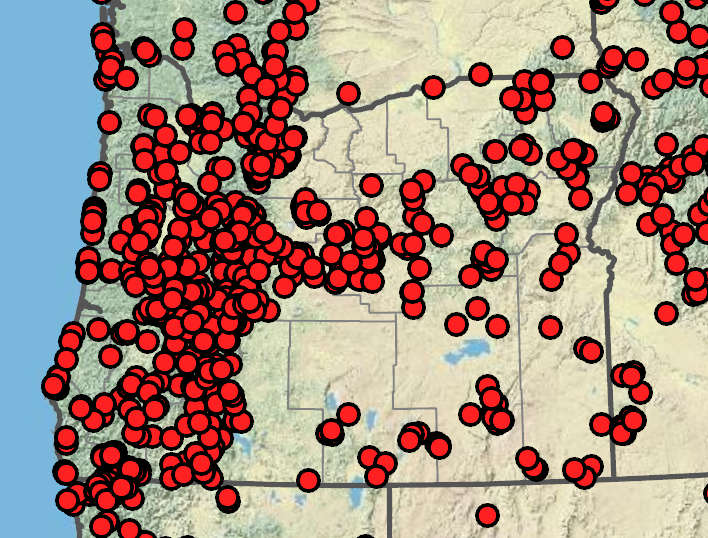Juncus howellii
Juncus ensifolius
Howell's rush
dagger-leaved rush, swordleaf rush
flat; grass-like, blue-green; up to 4.5 mm wide;
auricles absent or 0.2– 2 mm.
flat; iris-like, blue-green, partially septate;
auricles usually absent (0.1–0.4 mm).
(2)5–20 clusters; clusters usually 2–8-flowered.
1–12(22) clusters; clusters often head-like, 3–70-flowered.
tepals 6, dark brown, papillose; inner usually longer than the outer;
stamens 6;
filaments 0.6–1.1 mm;
anthers 1.2–2.6 mm;
styles 1.2–3.2 mm.
tepals 6, brown to often dark brown or black;
stamens 3;
filaments 0.6–1.1 mm;
anthers 0.4–0.7 mm;
styles 0.2–0.8(1) mm.
obovoid; shorter than the tepals, brown; acute, 3-chambered.
longer than or equaling tepals, dark brown to blackish;
apices obtuse or acute and abruptly tapered to short beak, 1-chambered.
slender, 0.6–1 × 0.25– 0.3 mm;
body 0.4–0.6 mm; tail 0.1–0.3 mm, 1 or 2 tails at least half the length of the seed body.
0.4–0.5(0.6) × 0.15–0.2 mm, apiculate, reticulate.
Juncus howellii
Juncus ensifolius
Springs, gravel bars, wet slopes, peatlands. 600–2200m. BW, Casc. CA, ID, WA. Native.
Auricle characters are occasionally unreliable, so this species is best separated from J. orthophyllus and J. regelii by the intermediate length of the tail on the seed, with one or both seed tails about half as long as the seed body. Juncus orthophyllus has apiculate seeds without a tail, and J. regelii has seed tails approximately as long as the seed body.
Shores, swales, springs, wet meadows, wet prairie, damp dunes, peatlands, ditches. 0–2500m. Throughout Oregon. CA, ID, NV, WA; north to Alaska, east to Saskatchewan, SD and CO, south to AZ and Mexico; Ontario and Quebec south to WI and NY; HI; northeastern Asia, Europe, New Zealand. Native.
With three stamens, this species is reliably separated from J. saximontanus, which has six stamens. Rare plants with variable stamen numbers in an inflorescence may represent hybrids and need investigation.
Peter Zika
Peter Zika
- Local floras:
CA,
OR,
WA
- Local Web sites:
CalFlora,
CalPhotos,
Flora NW,
PNW Herbaria
WildflowerSearch
iNaturalist (observations)
USDA Plants Database
- LBJ Wildflower Center
- SEINet
- Plants of the World Online
- Encyclopedia of Life
- Wikipedia
- Google Image Search
- Local floras:
BC,
CA,
OR,
WA
- Local Web sites:
CalFlora,
CalPhotos,
Flora NW,
PNW Herbaria
WildflowerSearch
iNaturalist (observations)
USDA Plants Database
- LBJ Wildflower Center
- SEINet
- Plants of the World Online
- Encyclopedia of Life
- Wikipedia
- Google Image Search


